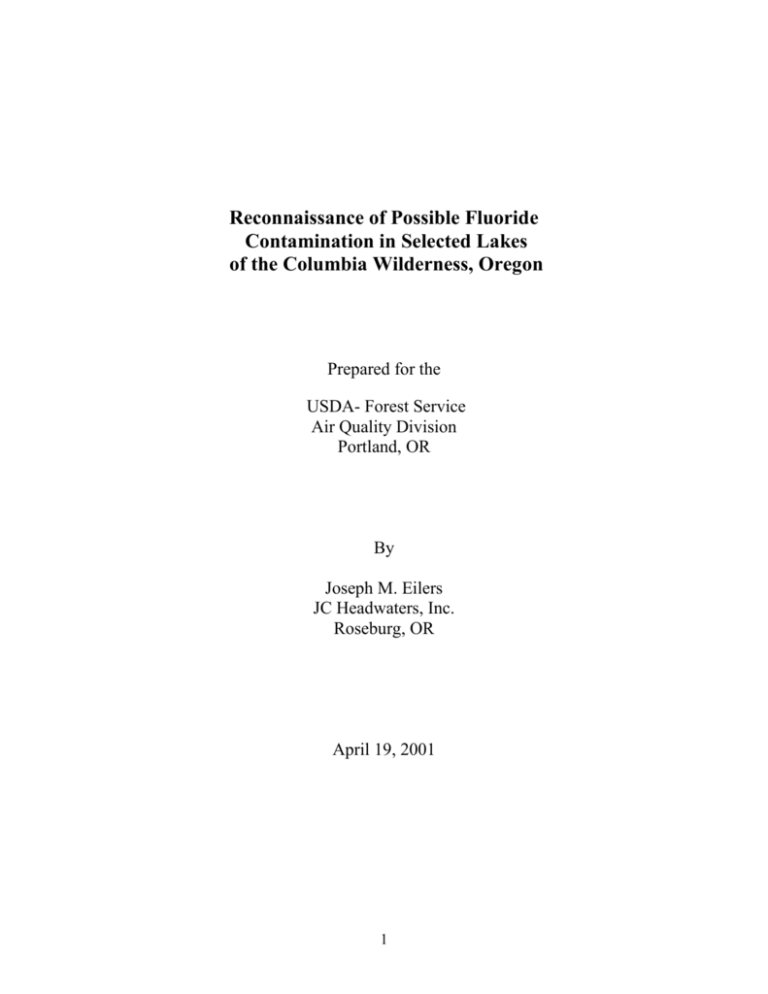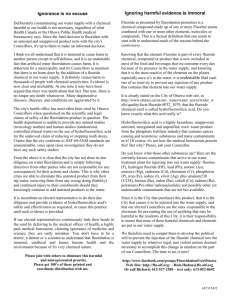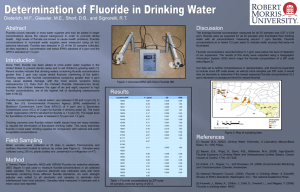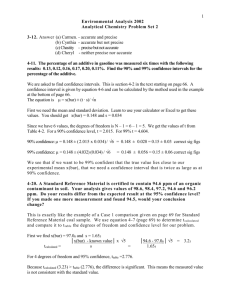Reconniasance of Possible Fluoride
advertisement

Reconnaissance of Possible Fluoride Contamination in Selected Lakes of the Columbia Wilderness, Oregon Prepared for the USDA- Forest Service Air Quality Division Portland, OR By Joseph M. Eilers JC Headwaters, Inc. Roseburg, OR April 19, 2001 1 EXECUTIVE SUMMARY Three lakes in the Columbia Wilderness, OR were sampled in fall 2000 to determine if fluoride in lake water and fish tissue were present in unacceptable levels. The decision to sample lakes in this area was based on sample results of Warren Lake in 1999, which showed elevated levels of fluoride, sulfur and ammonium in the lake. The results of the sampling in 2000 showed that fluoride concentrations in all three lakes were largely undetectable. However, fluoride concentrations in bone tissue from brook trout present in the lakes showed median concentrations of 116 ppm in North Lake, 171 ppm in Warren Lake, and 435 ppm in Rainy Lake. The presence of significant quantities of fluoride in the fish, despite the absence of measurable quantities in the lake water, suggests that the fish were previously exposed to fluoride. The current absence of fluoride in the lake water indicates that the fluoride was not derived from geologic sources. The fish constitute a self-sustaining population, indicating that they acquired the fluoride while in the lakes. The data suggest that the fish were exposed to episodic inputs of fluoride from atmospheric sources. 2 INTRODUCTION Lakes are highly sensitive receptors of air pollution as evidenced by their responses to acidic inputs from sulfur and nitrogen (Driscoll et al. 2001) and trace contaminants (Charles and Norton 1986). Evidence of air pollution inputs can be viewed from changes in lake water chemistry, changes preserved in the sediments, or from changes to the biota that live in the lakes. Historically, concern regarding damage to aquatic resources from air pollution in the western United States has been relatively limited because of the low ambient concentrations of sulfate and nitrate in the region’s precipitation (cf. Baker et al. 1990). Although regional concentrations of atmospheric sulfate and nitrate remain low, there is the potential for local emissions to cause site-specific problems in the West. One of the emissions of concern is fluoride, which is emitted from some aluminum smelters. In the electrolytic method of aluminum production, cryolite (Na3AlF6) is used as a solvent for Al2O3. Molten cryolite exerts a high vapor pressure, allowing fluoride to escape in the exhaust (Sawyer and McCarty 1978). The use of electrostatic precipitation units has been used in the past to reduce emissions of fluoride. Natural sources of fluoride include weathering of apatite [(Ca5(Cl,F,OH)(PO4)], fluorite [CaF2], cryolite and other minerals in both sedimentary and volcanic rocks. Hydrogen fluoride (HF) gas from volcanic eruptions can also be a significant source of atmospheric fluoride. Fluoride is also present in seawater (1.3 mg/L, Weast [1983]) and inputs of marine aerosols could be a small source of this ion. In 1999, we sampled six lakes in the Mt. Jefferson and Columbia Wildernesses as part of a general review of lake conditions in the region (Eilers 2000). The results showed that at least one lake in the Columbia Wilderness, Warren Lake, contained what appeared to be elevated concentrations of fluoride, sulfur, and nitrogen. The concentrations were not high, but were noteworthy in that concentrations of fluoride this high was uncommon in lakes of the Cascades. Eilers et al. (1987) reported a median concentration of 0.6 ueq/L fluoride for lakes in the Cascades with an 80 percentile value of 1.0 ueq/L. A follow-up sampling was implemented to determine if the concentrations of fluoride measured in Warren Lake were repeatable and to determine if the presence of fluoride could be 3 detected in other lakes in the Columbia Wilderness. In addition, the sampling design was expanded to include collection of fish in the lakes to determine if there was evidence of long-term exposure to fluoride. The purpose of this report is to summarize the results of the lake and fish sampling. METHODS Four lakes were selected for sampling in the Columbia Wilderness located in the Mt. Hood National Forest. The lakes selected for sampling were Warren, Palmer, North, and Rainey and are located about 50 km east of Portland, OR and about 5 km south of the Columbia River within the Columbia Gorge National Scenic Area. Water samples were collected from Warren, North, and Rainey in September and October, 2000 by JC Headwaters (JCH) staff. Palmer Lake was not accessible during the sampling window and was not included in the study. Triplicate water samples were collected from the center of the lakes using new Nalgene® bottles that had been soaked in that particular lake prior to collecting the sample. Duplicate samples were shipped via overnight courier to the USDA Forest Service laboratory in Fort Collins, CO for analysis of major ions. Split samples were collected, frozen, and later shipped to the CH2M Hill laboratory in Corvallis, OR for analysis of fluoride, ammonia, nitrate, and conductance. All ions at the Forest Service laboratory were analyzed with a Dionex ion chromatography system. Ten fish per lake were collected from Warren and Rainey lakes; nine fish were collected from North Lake. All fish were collected using fly-fishing techniques. The brook trout were placed into separate Ziploc® bags, frozen, and shipped frozen to the University of Minnesota Soil Science Laboratory for analysis of fluoride in bone tissue. The bones were extracted from the fish by warming the fish in a microwave, which facilitated separation of the bone and flesh. The bones were cleaned with deionized water, brushed, and picked with tweezers. The fish bones were ashed at 600 °C in porcelain crucibles. A 4 subsample of 100 mg of ash was mixed with 5 mL of 4N HNO3, neutralized with sodium hydroxide. The solution was brought up to 45 mL at which time 5 mL of TISAB buffer was added. Fluoride was measured in the solution with an Orion combination ion selective electrode. Results were compared checked with NIST standard reference material (SRM 1486 bone meal; 800 ppm F). Recoveries were typically about 102%. The methods are similar to those developed by Singer and Armstrong (1968) for rat bones and later modified by Ke et al. (1970) for fish bones. RESULTS Water chemistry from the three lakes is shown in Table 1. In general, the lake chemistry appears normal and unremarkable. Fluoride was measurable in only one sample from Warren Lake and that value was only slightly above detection. Concentrations of ammonia, nitrate, and sulfate were all low and within values not unexpected for lakes in the Oregon Cascades. pH values were all between 6.3 to 6.9 and ANC values ranged from 32 to 362 ueq/L. Quality assurance checks and split sample results indicate that the results are reasonably accurate. Concentrations of fluoride in fish (all individuals were brook trout [Salvelinus fontinalis]) bones ranged from 27 ppm to 550 ppm (Table 2). The lowest median concentrations were observed in North Lake at 115 ppm and the highest were observed in Rainy Lake at 430 ppm (Figure 1). Standard deviations in concentrations ranged from 104 ppm in Warren Lake to 146 ppm in Rainy Lake. There was a weak relationship (r2 = 0.19) between total extractable bone mass in the fish and fluoride concentrations in the bone tissue (Figure 2). 5 DISCUSSION The concentrations of fluoride in the lake waters were virtually undetectable and are somewhat of a surprise given the observations from Warren Lake from the previous year (Table 1). Not only did fluoride decrease between the two samplings, but also a similar change is evident for sulfur and nitrogen. If we assume that the values measured in 1999 were not caused by sample contamination or analytical error, then there appears to be a change in the lake that is consistent with a reduction in input of sulfate, nitrate, and fluoride, all ions with potential atmospheric sources. The absence of fluoride in Warren Lake in 2000 indicates that its presence in 2000 was most likely not caused by geologic (ie.,watershed) sources. A complete replacement of the lake water in the year between the two samplings is highly likely given the small, shallow nature of the lake (maximum depth = 2.5m) and the high annual precipitation for the area (> 2m based on interpolated values from Taylor and Hannan [1999]). The concentrations of fluoride in the fish indicate that the fish have been exposed to fluoride for a significant period. The fish were all about 5 to 11 inches (130 to 280 mm) and represented self-sustaining brook trout populations from introductions that occurred a number of years earlier (David Liscia, ODFW, Clackamas OR, pers. comm.). Since the fish were not exposed to fluoride at a hatchery, then they must have acquired the fluoride from the lakes. The water chemistry data indicate that there is no fluoride currently present in the lakes, which eliminates geologic sources as the origin of the fluoride. Had fluoride been derived from weathering reactions in the watershed, the concentration of fluoride may have fluctuated, but probably not greatly with respect to other major ions. Total ion concentrations in Warren Lake decreased about 20 percent between 1999 and 2000. The remaining explanation for the fluoride in the fish is that the fluoride was derived from atmospheric sources that have since been flushed from the lakes. In addition to the previous year’s water chemistry data from Warren Lake, there is other supporting information for this interpretation. Geiser (2001) measured concentrations of fluoride in 6 the lichen, Platismatia glauca, from a number of areas in the Oregon and Washington Cascades. The lichen tissues from the immediate vicinity of Warren Lake were significantly (p < 0.05, Dunnett’s Method) greater than sites from three other areas in Oregon (Palmer Lake, North Lake, and HJ Andrews Experimental Forest). Samples from near Rainy Lake also showed some elevated fluoride concentrations. Fluoride concentrations from the vicinity of Warren Lake were similar to values measured in the Pack Forest, WA. Lichens in the vicinity of Warren Lake showed visible signs of damage (Geiser 2001). It is difficult to assess the ecological significance of the measured fluoride concentrations in the brook trout from these three lakes. Public health standards are based on ambient water concentrations (MCL of 4.0 mg/L for drinking water [USEPA 1985]) and effects to wildlife are not always considered when formulating the standards. Canada offers guidelines for contaminants in fish and fish products that include an action level of 150 ppm of fluoride for fish protein concentrate (Canada Food Inspection Agency, Fish, Seafood and Production Division). This action level is for edible tissue, which presumably excludes bone tissue. We would expect bone tissue to exhibit higher concentrations than protein because of the affinity of fluoride for bone tissue. Fluoride is highly electronegative and can substitute for hydroxide ions in forming strong covalent bonds with divalent cations (Ca and Mg). This characteristic of fluoride to participate in substitution reactions in bone formation can lead to excessive fluoride concentrations in the bone. This condition, known as fluorosis, can cause severe bone deformities and visual mottling of the teeth in mammals. The specific levels at which this can cause problems in fish has not been reported, although drinking water concentrations of fluoride above 4.0 mg/L were associated with osteosclerosis (De Zuane 1990). In addition to forming strong complexes with calcium, fluoride also forms strong complexes with aluminum Hem (1985). It is conceivable that aluminum hydroxy-fluoride complexes were formed and deposited in the sediments, thus removing both aluminum and fluoride from the water column. If so, the sediments may have a record preserved of atmospherically-deposited aluminum. 7 A brief review of fluoride toxicity on salmon found that concentrations of fluoride above 0.2 mg/L (10.5ueq/L) could be lethal and inhibiting to migrating salmon (Foulkes and Anderson 1994). Foulkes and Anderson (1994) argued that the current EPA permissible discharge level of 1.5 mg/L of fluoride is not adequate to protect anadromous fish stocks and that fish exposed to these levels will experience lethal or sublethal effects. They suggested that a more appropriate fluoride level would be 0.2 mg/L. Most of the laboratory studies of fish toxicity to fluoride (using sodium fluoride and rainbow trout) show that lethal effects vary widely as a function of temperature and water hardness. For example, Pimental and Bulkley (1983) found an inverse relationship between fluoride toxicity and hardness whereby fluoride toxicity increased with decreasing hardness of the source waters. The minimum level of hardness they tested was 17 mg/L; by comparison, the hardness in Warren Lake is less than 1 mg/L, which presumably would greatly increase the toxicity to fish exposed to fluoride. In a study on the Columbia River, Damkaer and Dey (1989) concluded that salmon loss at John Day Dam for the period 1982-1986 was attributed, in part, to fluoride contamination from an upstream aluminum smelter. Typical fluoride exposure concentrations were 0.5 mg/L in 1982 resulting in 55% mortality and 0.2 mg/l in 1985 resulting in only 5% mortality. The data presented here suggest that sources in or near the Columbia River Gorge have released atmospheric emissions of fluoride in 1999 (and likely earlier) resulting in fish being exposed to elevated concentrations of fluoride. Although these emissions apparently have declined, their earlier presence in the lake water was sufficient to result in accumulation into fish bone tissue. There are three possible atmospheric sources of fluoride to these lakes: marine, volcanic, and anthropogenic. Marine aerosols contribute measurable sodium and chloride ions to these lakes, but the relative abundance of fluoride in seawater is so low that this source is probably insufficient to account for the concentrations observed in these trout. Volcanic emissions from nearby Mt. St. Helens could have contributed significant amounts of fluoride to the region in 1980 and for several years thereafter. However, emissions have virtually ceased in the last decade, although fluoride present in the volcanic ash and deposited in the watershed may periodically flush into the lakes during major runoff events. Fluoride is also emitted from 8 aluminum smelters in the region. Two aluminum smelters in Oregon emitted over 100 tons of F and HF in 1998 and 1999 (Oregon Dept. Environmental Quality, emissions inventory). Anthropogenic emissions of fluoride have declined radically with the recent closure of most smelters in the region. In summary, fluoride was not present above detection limits in the waters of the three lakes sampled. However, fluoride was present in the bones of the brook trout from these lakes, although it is unclear whether the concentrations measured constitute elevated levels. The source of the fluoride is likely atmospheric, although it cannot be determined with these data if the predominant input is from anthropogenic sources. ACKNOWLEDGEMENTS This work was supported through Purchase Order 43-04H1-0-0073 from the USDA Forest Service to JC Headwaters, Inc. The project officer was Robert Bachman. I am indebted to Dr. William Dancer, University of Minnesota, for conducting the fluoride analyses of the fish. B. Eilers and I. Gunter provided field support and ichthyological expertise. 9 LITERATURE CITED Baker, L.A., P.R. Kaufmann, A.T. Herlihy, and J.M. Eilers. 1990. Current status of surface water acid-base chemistry. State of Science/Technology Report 9. National Acid Precipitation Assessment Program. Washington, D.C. 367 pp + appendices. Charles, D.F. and S.A. Norton. 1986. Paleolimnological evidence for trends in atmospheric deposition of acids and metals. Pages 335-431 in Acid Deposition: Longterm Trends. Committee on Monitoring and Assessment of Trends in Acid Deposition. National Academy Press, Washington, D.C. Damkaer, D.M., and D.B. Dey. 1989. Evidence of fluoride effects on salmon passage at John Day Dam, Columbia River, 1982-1986. North American Journal of Fisheries Management. 9:154-162. De Zuane, J. 1990. Handbook of Drinking Water Quality. Van Nostrand Reinhold. New York. 523 pp. Driscoll, C.T., G.B. Lawrence, A.J. Bulger, T.J. Butler, C.S. Cronan, C. Eager, K.F. Lambert, G. E. Likens, J.L. Stoddard, and K.C. Weathers. 2001. Acidic deposition in the northeastern United States: Sources and inputs, ecosystem effects, and management strategies. BioScience 51: 180-198. Eilers, J.M., P. Kanciruk, R.A. McCord, W.S. Overton, L. Hook, D.J. Blick, D.F.Brakke, P.E. Kellar, M.S. DeHaan, M.E.Silverstein, and D.H. Landers. 1987. Characteristics of lakes in the western United States. Volume II. Data compendium for selected physical and chemical variables. EPA-600/3-86/054b, U.S. Environmental Protection Agency, Washington, D.C. 492 pp. Eilers, J.M. 2000. Sampling deposition-sensitive lakes in the Mt. Jefferson and Columbia Wilderness Areas. E&S Environmental Chemistry, Inc. 27 pp. Foulkes, R.G. and A.C. Anderson. 1994. Impact of artificial fluoridation on salmon species in the Northwest USA and British Columbia, Canada. Fluoride 27:220-226. Geiser, L. 2001. Fluorine air pollution at Warren Lake --- Does it exist? Results of a lichen study. Siuslaw National Forest, Corvallis, Oregon. 9 pp. Hem, J.D. 1985. Study and interpretation of the chemical characteristics of natural water. U.S. Geological Survey Water Supply Paper #2254. 3rd edition. 263 pp. Ke, P.J., H. Power, and L.W. Rieger. 1970. J. Sci. Food & Agriculture. 21:108-109. Pimental, R. and R.B. Bulkley. 1983. Influence of water hardness on fluoride toxicity to Rainbow trout. Environmental Toxicology and Chemistry. 2:381-386 10 Sawyer, C.N. and P.L. McCarty. 1978. Chemistry for Environmental Engineering. 3rd edition. McGraw-Hill Book Company. New York. 532 pp. Singer, L. and W.D. Armstrong. 1968. Analytical Methods. 4:613-614. Taylor, G.H. and C. Hannan. 1999. The Climate of Oregon. Oregon State University Press. Corvallis, OR. 211 pp. U.S. Environmental Protection Agency. 1985. Fluoride; National Primary Drinking Water Regulations; Final Rule and Proposed Rule (40 CFR PARTS 141,142,143). Weast, R.C. (ed). 1983. CRC Handbook of Chemistry and Physics. 64th edition. CRC Press, Inc. Boca Raton, Florida. 11






